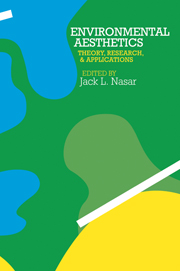Book contents
- Frontmatter
- Contents
- List of figures
- List of tables
- List of contributors and participants
- Acknowledgments
- Preface
- Section I Theory
- Section II Empirical studies
- Editor's introduction
- A Methodological comments
- B Architectural interiors
- C Architectural exteriors
- D Urban scenes
- Editor's introduction
- 18 Visual preferences in urban street scenes: a cross-cultural comparison between Japan and the United States
- 19 Perception and evaluation of residential street scenes
- 20 Planning concerns relating to urban nature settings: the role of size and other physical features
- 21 The effect of sign complexity and coherence on the perceived quality of retail scenes
- E Natural and rural scenes
- Section III Applications
- References
- Index of authors
- Subject index
18 - Visual preferences in urban street scenes: a cross-cultural comparison between Japan and the United States
Published online by Cambridge University Press: 05 September 2013
- Frontmatter
- Contents
- List of figures
- List of tables
- List of contributors and participants
- Acknowledgments
- Preface
- Section I Theory
- Section II Empirical studies
- Editor's introduction
- A Methodological comments
- B Architectural interiors
- C Architectural exteriors
- D Urban scenes
- Editor's introduction
- 18 Visual preferences in urban street scenes: a cross-cultural comparison between Japan and the United States
- 19 Perception and evaluation of residential street scenes
- 20 Planning concerns relating to urban nature settings: the role of size and other physical features
- 21 The effect of sign complexity and coherence on the perceived quality of retail scenes
- E Natural and rural scenes
- Section III Applications
- References
- Index of authors
- Subject index
Summary
While some visual preferences in the environment may be influenced by culture, others – universals – may be common to many cultures. Environmental psychologists have examined the relationship between visual aspects of the physical environment and affect (for a review, see Wohlwill, 1976). Acknowledging individual variation in response, some researchers have sought with some success to define general principles that guide preference. However, much of the research has centered on North American and Western European populations. Although these populations are diverse, their common background (as Westerners) may have influenced their preferences. Cross–cultural comparisons with other populations (Canter and Thorne, 1972; Sonnenfeld, 1969) have provided and can provide further insight into the nature of environmental preference. This research represents one such comparison – between Japan and the United States. The aim was to uncover those preferences common to persons in both of these complex and industrialized cultures.
While sharing a status as developed and industrialized nations, Japan and the United States have distinct differences in their cultures and physical environments (Canter and Canter, 1971; Hall, 1966, pp. 49–54; Rapoport, 1977, p. 43). If, despite these differences, common patterns of preference in relation to the visual environment are found among persons from these two nations, then such preferences might be interpreted as representing universals.
In this research, several characteristics of the visual environment were selected as most likely to relate to preferences for urban scenes.
- Type
- Chapter
- Information
- Environmental AestheticsTheory, Research, and Application, pp. 260 - 274Publisher: Cambridge University PressPrint publication year: 1988
- 8
- Cited by



